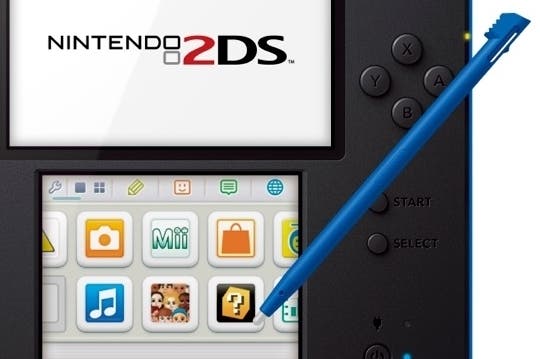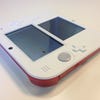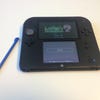Nintendo 2DS hands-on
How does Nintendo's odd new handheld shape up to the 3DS, and how does it feel? New comparison shots inside.
Just as Apple is rumoured to be working on a budget-price iPhone to attract a larger audience, Nintendo is hoping to capture a different userbase with the 2DS, the latest iteration on its handheld formula. Its launch is unlikely to upset anyone who's recently bought a 3DS or 3DS XL - and don't expect either of those two models to disappear any time soon. Positioned at a lower price point and targeted at a wider market, the fact 2DS will launch alongside family-friendly titles Pokémon X and Y on 12th October is no coincidence. The wedge-shaped handheld will be a sibling to the existing 3DS family, an additional option rather than any sort of replacement or improvement.
Top of the list of changes is the removal of the console's 3D option. Once the 3DS' headline feature, Nintendo's much-boasted-of glasses-free 3D functionality was quietly sidelined as an additional novelty following the console's price cut and marketing relaunch. No 3DS games technically require 3D, after all, although some are undoubtedly enhanced by it being an option (Super Mario 3D Land's viewpoint shifting puzzles spring to mind).
Much could be made of Nintendo's decision to excise even the option of 3D, then, but its removal here is less of a U-turn than immediate impressions might suggest. The feature is still present in the 3DS and XL, after all - there is no indication of new models for either of those tiers. A version of the handheld without 3D is simply confirmation of what has been apparent for some time across the wider technology and entertainment sectors - that the pull factor of 3D as a point of differentiation is not as convincing as once expected. The post-Avatar 3D bubble burst a long time ago - this is Nintendo finally moving on.
The 2DS' other big change is the removal of Nintendo's iconic DS and 3DS clamshell design. It's the first Nintendo handheld since the days of the Game Boy Advance family to be a simple, flat shape, and there is something of the company's earlier handhelds in its form. Nintendo has imagined a taller version of the first Game Boy Advance, now with two screens nestled in the middle instead of one.
The twin displays are back to the original 3DS' dimensions following Nintendo's supersized XL versions. Simply put, there's no difference in how games look on 2DS and 3DS when the latter is set to its 2D mode. Another change is the 3DS' dual speaker setup. The 2DS only has one, although stereo and surround options are still available via headphones. And, unlike the 3DS XL, you will get a charger included.
Inside the console it is very much the 3DS in a new shell - it runs the same firmware and has the same DS back-compatibility. It even has the 3DS' twin camera on its rear so you can take 3D photos. These are displayed in 2D, naturally, but can be swapped over to 3DS via SD card to be viewed in three dimensions.
"The post-Avatar 3D bubble burst a long time ago - this is Nintendo finally moving on"
Holding the 2DS' matte plastic form is comfortable enough - your hands naturally gravitate to holding it midway up, index fingers on shoulder buttons. The circle pad, D-pad and face buttons are in easy reach, while Start and Select now get their own discrete buttons below the ABXY diamond. The Home button is now a larger, more prominent option, meanwhile - much easier to depress than its clustered 3DS equivalent.
Game cartridges are loaded from the device's top in a slot that is now positioned off-centre, while the machine's right side holds the SD card and stylus. The headphone jack, positioned at the front left of the handheld, is accompanied on the right by a new Sleep Mode slider. The latter is a necessary addition with no lid to close, but somewhat of a clumsy workaround rather than the natural motion of closing the 3DS' lid when finishing playing.
There's no feeling of luxury while holding the machine, but that, I suppose, is the point. It is sturdy rather than sleek, meant for backpacks or a large back pocket, school bus rides or long journeys in the back of a car.

It's easy to understand the 2DS' form factor when considering the wider audience and lower price point, then, but its announcement still comes as something of a surprise. 3DS sales this year improved on 2012 thanks to a slew of quality first-party titles such as Luigi's Mansion 2, Fire Emblem: Awakening and Animal Crossing: New Leaf, the latter of which enjoyed a residency in the UK chart somewhat reminiscent of the company's DS and Wii glory days.
But Nintendo knows the 3DS is still nowhere near as successful as its predecessor. Animal Crossing may have earned itself regular chart appearances during the slow summer months but it has not replicated the kind of mass-market success seen by DS smash hits Brain Training or Nintendogs. So, while Nintendo is hurting in the home console market (evidenced by today's Wii U price cut), Nintendo is seeking to reinforce its dominance where it remains king. Within the handheld space, the 2DS may be an important weapon.
Released alongside must-have software starring one of Nintendo's biggest brands, the 2DS is a new entry point into the 3DS (and DS) software library. The company's huge back catalogue of evergreen titles hold their price remarkably well, after all. A cheap solution for users to put down their smartphone and pick up something that plays these games seems a reasonable idea.
The announcement of new gaming hardware - Nintendo hardware especially - is rare enough that its unveiling can draw ire if it is not specifically targeted at the core audience. But this device is not replacing existing offerings (in a similar way to the newer Wii form factor that removed GameCube back-compatibility) or being developed instead of a next iteration. The 2DS may not be for you or me, or for anyone who already has a 3DS or XL. But for those who don't, it's the easiest way yet to get involved.







